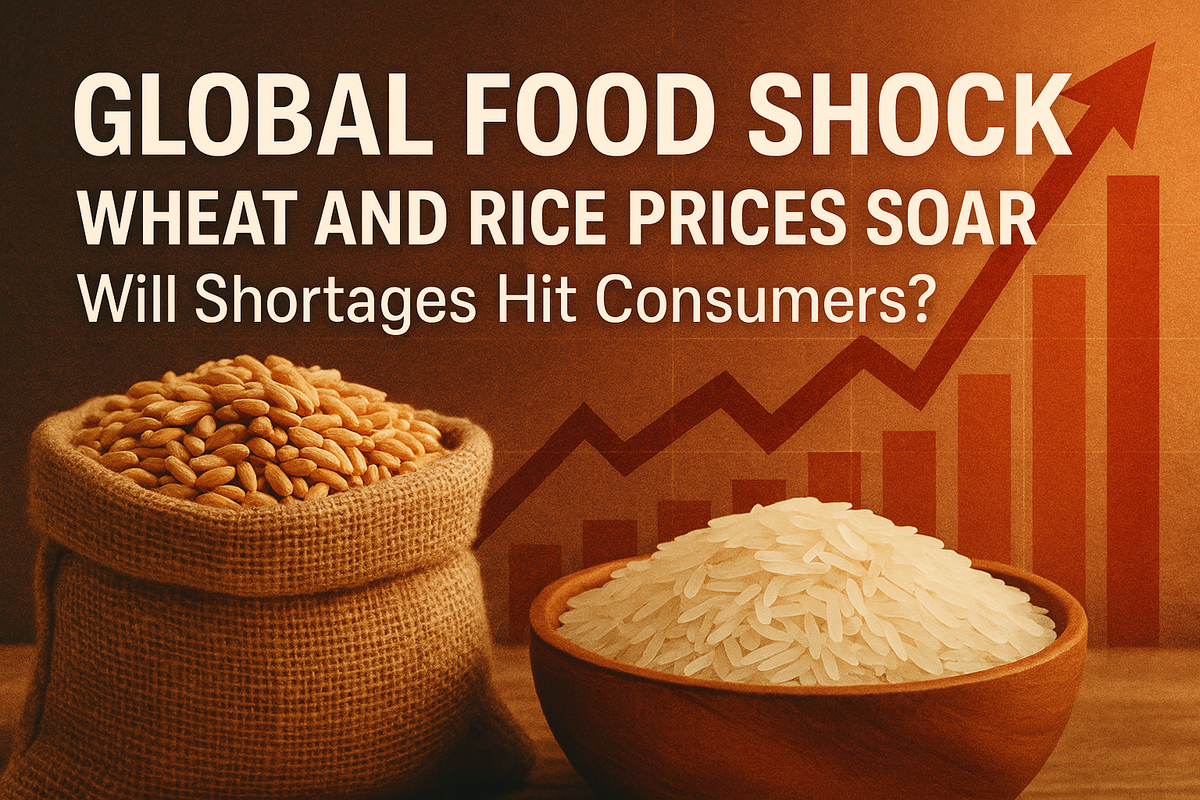Global Food Shock: Wheat and Rice Prices Soar Will Shortages Hit Consumers?
Wheat and rice prices have surged over 40% in 2025, driven by droughts, war, and export bans. This global food shock is triggering protests, hunger, and urgent government interventions across vulnerable regions.

Introduction: A Perfect Storm in World Food Markets
Globally, supermarket shelves are growing more expensive at a rate that is alarming. In 2025, prices for the world's staple foods wheat and rice are hitting all-time highs, creating fear of shortages, civil disturbances, and poverty exacerbated in fragile areas.
Based on statistics from the Food and Agriculture Organization (FAO) and Reuters, the worldwide price of wheat has risen more than 40% year-to-date, and rice has increased more than 30%. These rises are not merely the consequence of straightforward supply and demand changes but a culmination of climate shocks, geopolitical tensions, export bans, and global food system structural weaknesses.
This article discusses:
- What's behind the surging prices of wheat and rice
- Which nations and consumers are most exposed
- How governments and global agencies are reacting
- What the crisis means for food security in 2025 and beyond
Why Are Wheat and Rice Prices Spiking So Quickly?
There is no single driver behind the crisis. Rather, a multi-factor collision has turned food markets on their head:
Extreme Climate Events
- Historic heatwaves and droughts in India, China, and Southern Europe have devastated crop yields.
- More than 60% of farming land in Southern Europe is "severe drought," according to the European Drought Observatory, and wheat crops in Spain and Italy are 20–30% below historic averages.
- India's monsoon, which is essential for rice cultivation, has grown more unpredictable. In June 2025, the India Meteorological Department affirmed that rain was 23% less than average, stressing paddy fields.
Export Restrictions and Protectionis
- India restricted export of non-basmati rice in 2024, which was further extended to 2025 due to poor crops. India provides over 40% of global rice exports any restriction has worldwide repercussions.
- Russia, the biggest wheat exporter, has set quotas and increased taxes on grain exports to balance domestic prices after unstable crops.
- Kazakhstan and Vietnam have also introduced new export limits, Bloomberg reported.
War and Geopolitical Instability
- The war in Ukraine has continued to hinder Black Sea grain exports. Despite the volatile corridors facilitated by the UN, intermittent attacks on ports and infrastructure have diminished shipping capacity.
- Insurance premiums for shipping via the Black Sea continue to be very high, deterring most traders.
Increasing Input Prices
- Fertilizer remains high because of shortages in natural gas and Belarusian and Russian sanctions, which are two of the largest potash producers.
- Farmers are paying more for diesel fuel, pesticides, and seeds, forcing small producers out of business.
Speculation and Commodity Markets
- Hedge funds and institutional investors are becoming increasingly speculating on agricultural futures as a hedge against market volatility and inflation.
- Reuters reports wheat futures on the Chicago Board of Trade reaching their highest levels since 2022.
Which Countries Are Most at Risk?
Though everyone is impacted by rising prices, low-income, import-dependent countries are most vulnerable.
Africa: Import Dependence Meets Drought
- Egypt, the biggest wheat importer globally, relies on Russian and Ukrainian grains for more than 70% of requirements. The state is finding it hard to subsidize bread.
- Nigeria and Kenya are experiencing poor local production because of drought and a high cost of fertilizer.
Asia: Rice Shock and Political Fallout
- In Bangladesh, rice prices have risen over 50%, triggering protests and putting pressure on the government's food reserve schemes.
- Philippines and Indonesia are competing to secure alternative supplies from Thailand and Myanmar, further pushing regional prices up.
Europe: Harvest Losses and Inflation
- Southern Europe experiences droughts and heatwaves simultaneously, cutting yields.
- Bread and pasta prices are increasing in Italy, Spain, and Greece.
North America: Sticker Shock at the Supermarket
- While the US and Canada boast strong domestic production, input prices and global price contagion are driving up retail costs.
- Shoppers say they're paying 20–25% more for bread, flour, and rice than they did a year earlier.
How Are Prices Impacting Consumers?
For millions, these price increases are not mere inconveniences—they are tipping families into hunger.
Retail Price Increases
- FAO Food Price Index shows cereals are now 24% above the 5-year average.
- In India, the Consumer Food Price Index rose 8.3% year-on-year, the highest in a decade.
- In Egypt, subsidized bread prices have increased by 20%, the first hike in over 30 years.
Food Insecurity and Social Unrest
- Nearly 345 million people are experiencing acute food insecurity, more than doubled from 2020, WFP states.
- Protests in June 2025 broke out in Bangladesh, Kenya, and Tunisia about rising food prices.
How Are Governments and Agencies Responding?
As panic sets in and food prices shoot up, governments worldwide are employing a multi-pronged approach to stabilize supply, mitigate consumer distress, and avert mass food insecurity. But the success of these measures is uneven, and most of the time they amount to short-term palliatives rather than lasting measures.
1. Export Diplomacy: Negotiating Bilateral Agreements In The Face Of Crisis
Confronted with mounting domestic demand and dwindling reserves, most food-importing countries are actively forging bilateral free trade agreements in a bid to lock in rice and wheat at favored prices.
- The Philippines signed a long-term rice import deal with Vietnam, providing a secure supply for its people in the face of narrowing Southeast Asian rice markets. The agreement is said to provide price caps and delivery guarantees to shield against volatility.
- Egypt, which relies heavily on wheat imports to support its subsidized bread program, is in advanced negotiations with Russia to boost shipments under a new pricing formula, even though there are international sanctions against Russian exports.
- A number of African and Middle Eastern countries are negotiating similar arrangements with India, Thailand, and Kazakhstan, patchworking together bilateral food security deals.
2. Subsidy Programs: Safeguarding the Most Vulnerable
Governments are also widening food subsidies to protect low-income groups from the full force of inflation.
- In India, the government added another ₹50,000 crore (about $6 billion USD) to the Public Distribution System (PDS) to provide subsidized rice and wheat to more than 800 million people. The program also provides free pulses and cooking oil under the Pradhan Mantri Garib Kalyan Yojana.
- The European Union sanctioned a €3 billion emergency drought aid package for Spain, Italy, France, and Greece farmers. The package will assist in covering crop insurance payments, irrigation improvements, and input subsidies.
- Indonesia and Bangladesh have extended their food voucher programs to add more staples and reach more urban poor households.
These relief measures are alleviating short-term distress but are taking a toll on national budgets especially in nations already struggling with debt and inflation.
3. Strategic Reserves: Tapping into Stockpiled Grains
A number of key food-producing countries are now selling off grain reserves to stabilize prices and deter hoarding.
- China, which holds one of the biggest storehouses of grain in the world, has sold more than 20 million tonnes of wheat and rice from its national reserves since April 2025, state media and customs data show.
- India drew down its Food Corporation of India (FCI) buffer stocks to subsidize the PDS and temper retail prices.
- The United States Department of Agriculture (USDA) released extra wheat from federal reserves to maintain school meal programs and food banks.
Although a welcome relief, analysts caution that these reserves are limited, and repeated drawing without refill threatens to lead to shortages or price shocks down the line if poor harvests continue.
4. International Coordination: Expiring Calls for Cooperation Over Isolationism
The international community is resisting isolationist food policy and urging cooperative action in order not to repeat the errors of past crises.
- The G20 Agriculture Ministers in Berlin in June 2025 put out a joint statement calling on countries to "avoid export bans and trade-distorting measures" which have the potential to increase worldwide shortages.
- The United Nations Food Systems Coordination Hub is brokering grain-sharing deals between deficit and surplus nations to streamline emergency relief.
- The World Bank and IMF are assisting low-income nations in restructuring food-related debts and financing new farm modernization initiatives.
Enforcement, however, continues to be voluntary and most nations are still opting for food nationalism as an alternative to cooperation when confronted with domestic pressure.
What Does This Imply for 2025 and Beyond?
Climate Adaptation Can No Longer Wait
The food shock has revealed an ugly reality: climate change is no longer an impending future threat it's already a present-day crisis in the world's breadbaskets.
Unless nations invest heavily in climate-resilient agriculture, experts say that these shocks will become more intense and frequent.
Some of the most crucial solutions are:
- Drought-tolerant crop varieties (like short-duration rice and heat-stressed wheat)
- Drip irrigation and moisture-retaining tillage methods
- Agroforestry and soil carbon sequestration
The FAO and CGIAR are presently supporting pilot initiatives in Sub-Saharan Africa and South Asia, but the pace of global uptake is sluggish.
Enhancing Supply Chain Resilience
The 2025 crisis underscores the risk of dependency on a handful of export centers. India, Russia, and Vietnam alone control global grain markets—when they retreat, the ripple effects are enormous.
Long-term measures need to involve:
- Localizing food systems via urban agriculture and local grain networks
- Diversifying import sources through regional trade blocs
- Investing in cold storage, logistics, and transport to reduce post-harvest losses
Stopping Commodity Speculation
Increased speculative trading has increased price volatility, disconnecting market performance from actual-world supply conditions.
In turn, regulators are considering:
- Stricter limits on speculative positions in futures contracts
- Higher margin obligations for riskier trades
- Forced disclosures by hedge funds and commodity companies
There are some economists comparing today to the 2008 food crisis, when speculative bubbles sparked riots in more than 30 nations.
Global Solidarity: Wealthy Countries Need to Do More
Wealthy countries need to understand that their grain policies, subsidies, and trade policies directly affect hunger in the Global South.
Policy recommendations include:
- Raising contributions to the World Food Programme
- Simplifying export restrictions on fertilizers and basic grain
- Abolishing food debt for heavily indebted countries
This is a test of global political and moral commitment to UN Sustainable Development Goal 2: Zero Hunger.
What Can Consumers Do?
Though governments and companies control most of the strings, consumers can also contribute to easing pressure on food systems worldwide.
Here's why:
- Cut Food Waste
In the world, more than 1.3 billion tons of food are wasted annually. Consumers in developed nations throw away up to 30% of all food bought. Planning meals, storing food effectively, and composting can go a long way.
- Buy Local Producers
Purchasing from local farmers lowers reliance on unpredictable global supply chains and promotes diversified, sustainable agriculture.
- Call to Demand Policy Action
Join or support groups advocating for climate policy, fair trade policy, and investments in food resilience.
Conclusion: A Global Wake-Up Call
The Global Food Shock of 2025 is no mere economic ripple it's a deeper systemic stress test.
It uncovers how tenuous and interdependent the contemporary food system is, and how rapidly climate change, war, and policy decisions can push millions into hunger.
Unless world leaders move swiftly and together, this year's price surge will turn into a chronic nightmare. Transformatory action is needed now not simply to stabilize prices, but to create a fairer, greener, more resilient food system for the future.
Sources
- Food and Agriculture Organization (FAO) Food Price Index – fao.org
- Reuters Commodities Desk – reuters.com/markets/commodities
- Bloomberg Agriculture Markets – bloomberg.com/markets
- European Drought Observatory – edo.jrc.ec.europa.eu
- India Meteorological Department Press Releases – imd.gov.in
- World Food Programme Reports – wfp.org
- CourtListener Legal Documents on Export Restrictions – courtlistener.com
- Justia Case Law on Trade Sanctions – justia.com
- Archive.org Historical Grain Reports – archive.org
- Google Trends – trends.google.com (Search: wheat prices, rice export ban)
- Official Press Releases from Ministry of Agriculture (India, Egypt, EU)
For more legal exposes and truth-behind-glamour stories, subscribe to AllegedlyNewsNetwork.com




